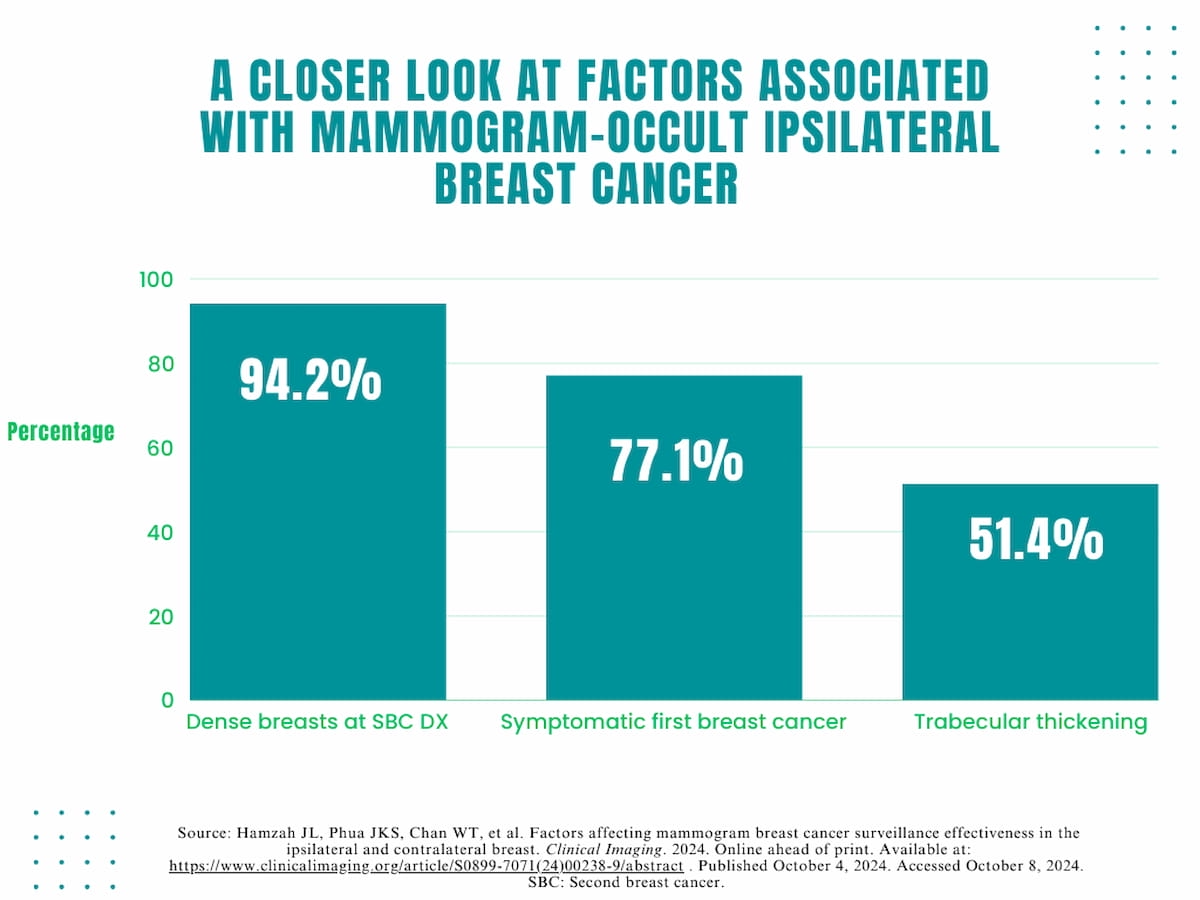For women with two breast cancer diagnoses in a 10-year period, emerging research suggests key imaging and clinical findings are associated with the development of a mammogram-occult ipsilateral breast cancer (ISBC).
For the retrospective multicenter study, recently published in Clinical Imaging, researchers reviewed data from 274 women who were diagnosed with ipsilateral or contralateral breast cancer within 10 years after an initial breast cancer diagnosis. The cohort included 166 cases of contralateral breast cancer (CSBC) and 108 cases of ISBC, according to the study. The study authors pointed out that 35 cases of ISBC (32.4 percent) and 42 cases of CSBC were mammogram occult.
Out of the 35 cases involving mammogram-occult ISBC, 33 women had dense breasts (94.2 percent) at the time of the second breast cancer (SBC), 27 women had a symptomatic first breast cancer (77.1 percent) and 18 women had evidence of trabecular thickening (51.4 percent).
“Symptomatic first breast cancers, prevailing dense breast tissue and presence of trabecular thickening on surveillance mammograms were associated with mammogram detection failure of the ipsilateral second breast event,” wrote lead study author Julie Liana Hamzah, M.D., who is affiliated with the Department of Breast Surgery at the Singapore General Hospital and the Division of Surgery and Surgical Oncology at the National Cancer Centre in Singapore, and colleagues.
The researchers also noted that 15 of the 42 women who had mammogram-occult CSBC (35.7 percent) had an initial primary breast cancer that was mammogram-occult.
“This constitutes a very relevant consideration, especially for women with ipsilateral mastectomy and a contralateral intact breast,” noted Hamzah and colleagues.
The study authors added that adjunct screening at the time of the SBC diagnosis was only utilized in 16.7 percent of the cases involving ISBC and 28.3 percent of the CSBC cases.
Three Key Takeaways
1. Risk factors for mammogram detection failure. Symptomatic first breast cancers, dense breast tissue, and trabecular thickening were key factors linked to the failure of mammograms in detecting ipsilateral breast cancer (ISBC).
2. Dense breast tissue and mammogram-occult breast cancer. Women with dense breast tissue at the time of their second breast cancer (SBC) are at higher risk for mammogram-occult ISBC with 94.2 percent of mammogram-ocult ISBC cases occurring in women with dense breasts.
3. Role of adjunct screening. Adjunct screening was underutilized in cases of SBC, but when it was utilized, it was associated with earlier cancer detection. The researchers noted that 81.5 percent of women with adjunctive screening had stage 0 or stage 1 breast cancer in comparison to 69.4 percent of women without adjunctive screening.
In examining the impact of adjunctive screening for women who had either an ISBC or CSBC diagnosis for a SBC, researchers found that 81.5 percent had stage 0 or stage 1 breast cancer in contrast to 69.4 percent in women who did not have adjunctive screening.
“Knowledge of the different risk factors affecting the separate breasts can provide additional guidance in the planning of a (personalized) surveillance program using adjunct imaging screening,” emphasized Hamzah and colleagues.
(Editor’s note: For related content, see “Mammography Study: Can Stand-Alone AI Enhance Detection of Interval Breast Cancer?,” “Radiology Experience, Breast Density and Screening Mammography: What New Research Reveals” and “AI Mammography Platform Shows Promising Results for Detecting Subclinical Breast Cancer.”)
In regard to study limitations, the authors acknowledged the possibility of inter-institutional and inter-observer variability in mammography reporting. They also conceded possible bias in determining the incidence of mammographically occult breast cancer due to a small number of asymptomatic breast cancer survivors who had adjunctive screening and a cohort mix of patients diagnosed at screening and those who had breast cancer detected during symptomatic assessment.
